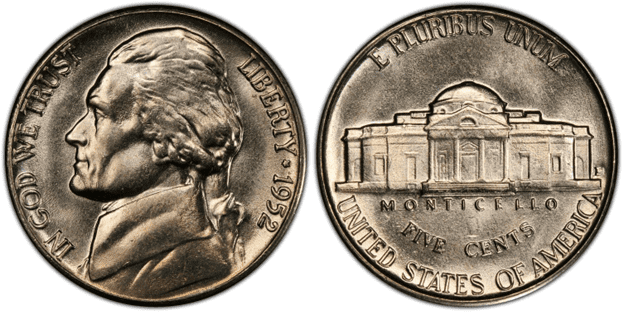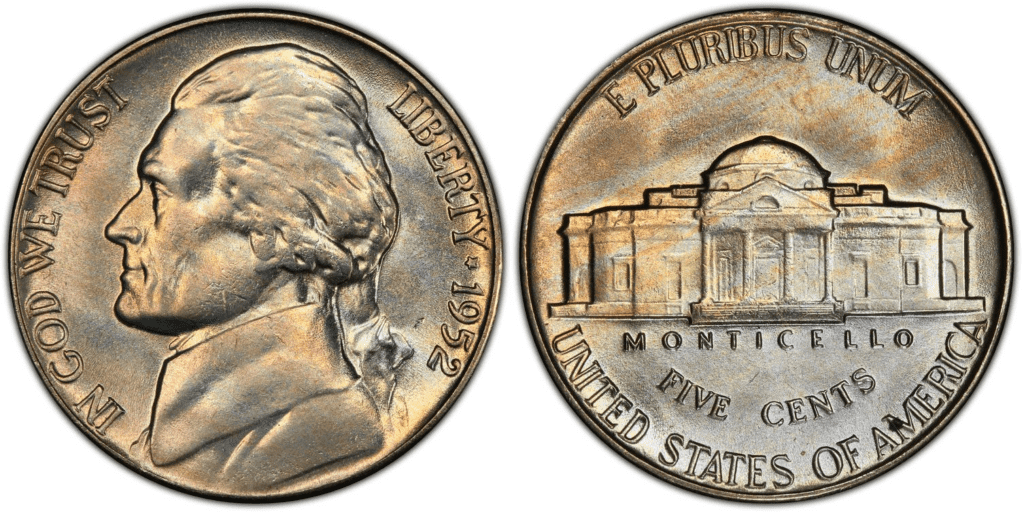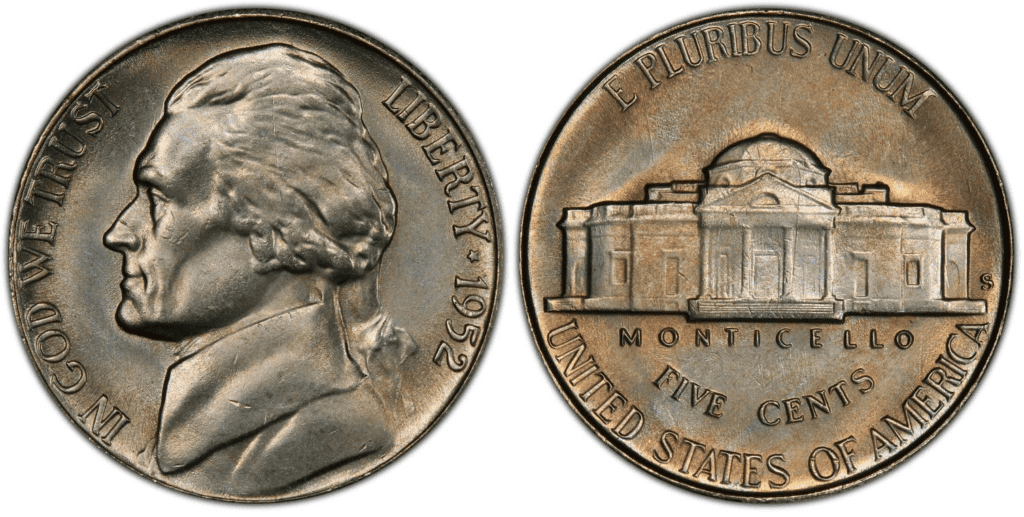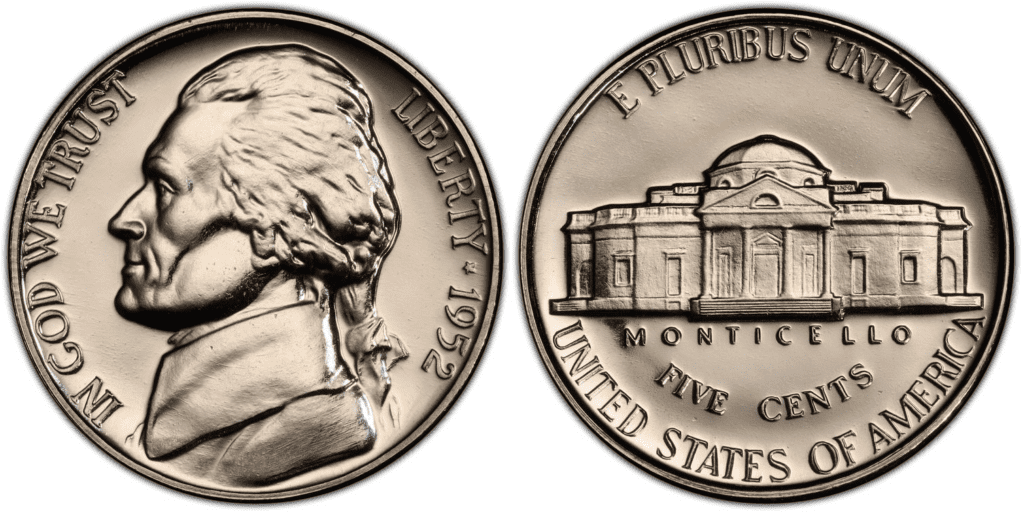What Is the 1952 Jefferson Nickel Made Of?
The 1952 Jefferson nickel is a five-cent coin composed of 75 percent copper and 25 percent nickel. Unlike the reeded edge of some U.S. coins, this five-cent piece has a plain edge. Its diameter is 21.2 mm, and it weighs 5 grams.
The Jefferson Nickel is notably known as the “Wartime Nickels” during World War II. From mid-1942 to 1945, the coins were made of 56% copper, 35% silver, and 9% manganese. Only in this period have the five-cent pieces been made with silver. After World War II in 1946, it returned to the composition of the copper-nickel alloy (75% copper and 25% nickel).
In 1938, the United States Mint unveiled a new design for the popular five-cent coin having the 3rd President of the United States, and Founding Father, Thomas Jefferson the subject of the coin. This design change was due to the difficulties with striking the Buffalo nickel.
The German-born American sculptor Felix Schlag designed the copper-nickel coin’s obverse. The U.S. Mint at that time held a competition for the new nickel coin design, and entrant Schlag was pronounced the winner, but eventually, his reverse design was asked to be changed entirely. As a result, his design for the Jefferson Nickel was discontinued in 2004.

You can see Jefferson’s bust facing left on the obverse side of the 1952 five-cent nickel coin. It also has the following inscriptions:
- IN GOD WE TRUST
- LIBERTY
- 1952
The reverse, on the other hand, features Monticello, Jefferson’s home and plantation in Virginia. You can also find the following inscriptions on this side of the coin:
- E PLURIBUS UNUM
- MONTICELLO
- FIVE CENTS
- UNITED STATES OF AMERICA
- D, S, placed at the right of Monticello, while no mint mark for Philadelphia mints
For easy recognition of all the ‘war nickels,’ the mint struck the reverse side of the Jefferson Nickel with a large mint mark above the Monticello. They put “P” for Philadelphia as the mint mark, then. But for the 1952 nickel, the mint removed that mint mark.
The 1952 Jefferson Nickel five-cent pieces were struck at the mints in Denver, San Francisco, and Philadelphia. About 116 million 1952 five-cent coin varieties were produced from these mints.
The Jefferson nickel is one of the U.S. longest-running coin series. The five-cent coin is still widely circulated and produced by the U.S. Mint even to this day.
1952 Jefferson Nickel Varieties
It is worth noting that the 1952 coin varieties are collected as part of a complete Jefferson nickel set. Many coin experts see a continued decline in the quality of the coinage for the 1952 nickels. They found the coin’s low quality was due to being poorly struck, spotted, or stained and often lackluster. Nevertheless, there is still a steady demand for this coin.
The 1952 Jefferson Nickels have three known varieties: 1952-D, 1952-P, and 1952-S. Unfortunately, while this coin was produced in large numbers then, there are still coin errors for the five-cent pieces.
Let’s take a look at the details of each variety below:
1952 D Jefferson Nickel
Year of minting: 1952
Mint Mark: D – appears at the right side of Monticello
Place of minting: Denver
Quantity produced: 30,638,000
Face Value: $0.05 (five cents)
Price: $0.50 to $25 (or more)
Mass: 5 grams
Edge: Plain
Designer: Felix Schlag
Composition: 75% Copper and 25% Nickel
Diameter: 21.2 mm
Thickness: Unspecified

photo source: PCGS
The Denver mint in the U.S. struck over 30 million Jefferson nickels in 1952. Many nickels circulated in the early 1950s were already worn, lost, or damaged. However, those available are sought in a high state of preservation.
You can quickly identify that the 1952 coin is struck at Denver mint by locating the “D” mint mark beside the Monticello on the right side, next to its rim.
1952 P Jefferson Nickel
Year of minting: 1952
Mint Mark: No mint mark
Place of minting: Philadelphia
Quantity produced: 63,988,000
Face Value: $0.05 (five cents)
Price: $0.50 to $25 (or more)
Mass: 5 grams
Edge: Plain
Designer: Felix Schlag
Composition: 75% Copper and 25% Nickel
Diameter: 21.2 mm
Thickness: Unspecified

photo source: PCGS
Its mintage of almost 64 million makes the 1952 P Jefferson Nickel the most common in the series. The five-cent piece is common to about MS65 grade, speculating that over ten thousand coins still exist.
Hence, most coin collectors still prefer to have ‘no wear to the surface’ for its mintage state. However, coins displaying the Full Step characteristics on its reverse side are rare and can be sold at a premium price.
You can quickly identify that the 1952 coin was minted in Philadelphia as you can’t see any mint mark on its reverse side where Monticello is engraved.
1952 S Jefferson Nickel
Year of minting: 1952
Mint Mark: S – placed at the right side of Monticello
Place of minting: San Francisco
Quantity produced: 20,572,000
Face Value: $0.05 (five cents)
Price: $0.50 to $14 (or more)
Mass: 5 grams
Edge: Plain
Designer: Felix Schlag
Composition: 75% Copper and 25% Nickel
Diameter: 21.2 mm
Thickness: Unspecified

photo source: PCGS
Of all the three mints, the San Francisco mint produced the fewest numbers of 1952 Jefferson Nickels, with only a little over 20 million for circulation. As a result, almost all the nickels wore from usage. This is the challenge of collectors today to find good quality 1952 nickels with an S mark.
On the reverse, when identifying the mint mark, you can find an “S” mark beside the Monticello building (on the right side and next to the rim).
1952 Proof Jefferson Nickel
Year of minting: 1952
Mint Mark: No mint mark
Place of minting: Philadelphia
Quantity produced: 81,980
Face Value: $0.05 (five cents)
Price: $0.50 to $37 (or more)
Mass: 5 grams
Edge: Plain
Designer: Felix Schlag
Composition: 75% Copper and 25% Nickel
Diameter: 21.2 mm
Thickness: Unspecified

photo source: PCGS
The Philadelphia Mint also produced proof coins of the nickel in 1952. They have produced more than 81 thousand pieces. This makes the proof coins in 1952 somewhat rare. The price starts at around $0.50 to $37.
List of 1952 Jefferson Nickel Errors
Mint-made error coins are common in the series of minted coins. These coins result from defective dies, planchets, or any mistakes made during coin striking. For example, while more than 116 million Jefferson Nickels were minted and struck in 1952, many error coins were still made.
The labels for each category of errors usually describe the cause of the error, such as:
- Die crack
- Rotated die
- Split planchet
- Clipped planchet
- Bank planchet
- Weak strike
- Off-center strike
- Punching error
- Lamination error
- Cladding flaw
- Missing design elements
As mentioned, the 1952 Jefferson Nickel is not exempt from coin errors. These error coins look unique and catch the attention of many numismatists. Because of their rarity, these error coins can be sold twice their face value. Some 1952 Jefferson Nickels are worth as much as $10,000 or even more.
The split planchet error is an excellent example of a mintage error for the 1952 Jefferson Nickel. Let’s take a look at the details in the image below:
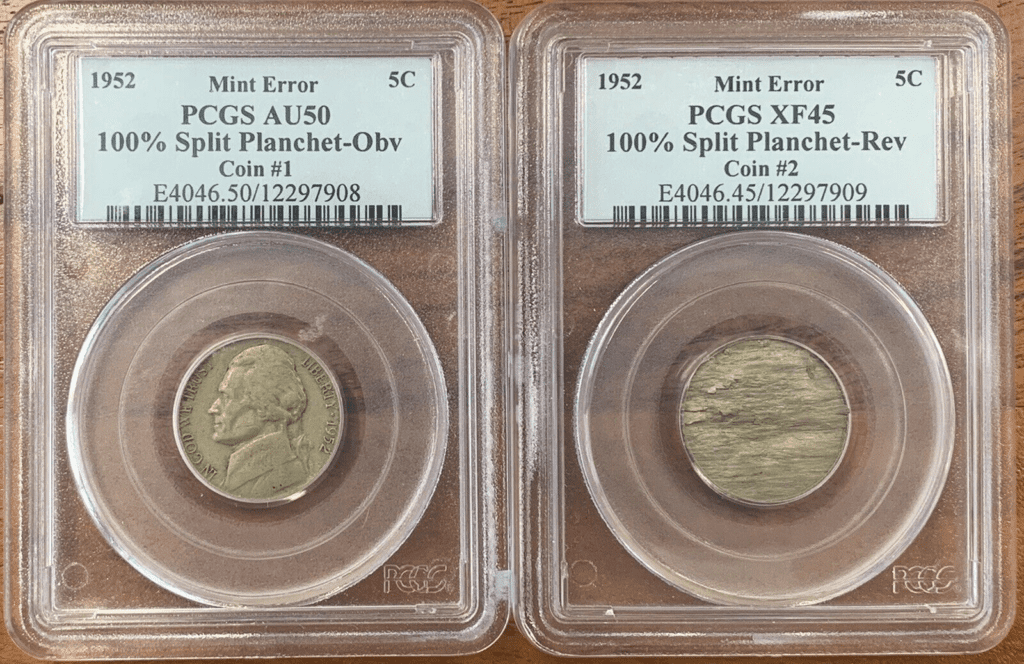
This 1952 Jefferson Nickel PCGS Mint Error has a 100% split planchet error. A split can happen either before or after the coin is struck. Typically, split errors are common to planchets made of a solid alloy, like the 1952 Jefferson nickels.
How Much Is The 1952 Jefferson Nickel Worth Today?
At the current pricing, according to the NGC guide, a 1952 Jefferson Nickel in a circulated condition costs between $0.10 and $0.30. However, the 1952 Jefferson Nickel can be worth as much as $4,750 in the open market for its pristine, uncirculated grade.
The melting value of 1952 Jefferson Nickel will primarily be based on the latest metal prices and specifications, especially for copper and nickel.
Combining the two metals and based on their current price value (75% copper value at $0.0315337 and 25% nickel value at $0.0361660), the 1952 Jefferson’s melt value is at $0.0676997.
You can also find in the chart below the value of the 1952 Jefferson Nickel according to its variety:
| Coin | Condition | Grade | Mintage | Value |
| 1952 P Jefferson Nickel | Circulated/mint | Not graded | 63,988,000 | $0.05 to $25 |
| 1952 P Jefferson Nickel | Uncirculated/mint | MS-65 | 63,988,000 | $12 to $41 |
| 1952 P Jefferson Nickel | Uncirculated/mint | MS-66 | 63,988,000 | $55 to $90 |
| 1952 P Jefferson Nickel | Uncirculated/mint | MS-67 | 63,988,000 | $190 to $1,265 |
| 1952 P Jefferson Nickel (Proof) | Uncirculated/proof | Not graded | 81,980 | $0.10 to $37.00 |
| 1952 P Jefferson Nickel (Proof) | Uncirculated/proof | PR-67 | 81,980 | $11 to $37 |
| 1952 P Jefferson Nickel (Proof) | Uncirculated/proof | PR-68 | 81,980 | $48 to $168 |
| 1952 P Jefferson Nickel (Proof) | Uncirculated/proof | PR-69 | 81,980 | $120 to $600 |
| 1952 D Jefferson Nickel | Circulated/mint | Not graded | 30,638,000 | $0.25 to $25.00 |
| 1952 D Jefferson Nickel | Uncirculated/mint | MS-65 | 30,638,000 | $9 to $20 |
| 1952 D Jefferson Nickel | Uncirculated/mint | MS-66 | 30,638,000 | $14 to $84 |
| 1952 D Jefferson Nickel | Uncirculated/mint | MS-67 | 30,638,000 | $110 to $288 |
| 1952 S Jefferson Nickel | Circulated/mint | Not graded | 20,572,000 | $8 to $14.00 |
| 1952 S Jefferson Nickel | Uncirculated/mint | MS-65 | 20,572,000 | $10 to $104 |
| 1952 S Jefferson Nickel | Uncirculated/mint | MS-66 | 20,572,000 | $15 to $94 |
| 1952 S Jefferson Nickel | Uncirculated/mint | MS-67 | 20,572,000 | $104 to $646 |
As you can see, the 1952 nickel can still be valuable, and some coins can be sold for hundreds and even thousands of dollars.
If you’re wondering how much a 1952 nickel can be sold for, take a look at these auction records for each variety:
- $16,450 – 1952-D 5C, FS with MS67 grade
- $14,950 – 1952 5C, DCAM (Proof) with PR68 grade
- $9,488 – 1952-S 5C, FS (Regular Strike) with MS66 grade
- $9,400 – 1952 5C, FS (Regular Strike) with MS66 grade
How Does The Grading System Work?
The Sheldon Scale is used by numismatists to provide a numerical value to coins. The Sheldon Scale goes from poor (P-1) to perfect mint state (P-1) (MS-70). Coins were originally evaluated using words to reflect their condition (Good, Fair, Excellent, Etc.). Unfortunately, coin collectors and dealers had different ideas about what each of these terms represent.
Professional numismatists joined together in the 1970s and established CoinGrading standards. These numismatists now assign grades at key places on the seventy-point scale, using the most regularly utilized numeric points in conjunction with the original adjective grade. The following are the most common coin grades:
-
-
- (P-1) Poor – Indistinguishable and probably damaged; if used, must have a date and mintmark; otherwise, rather battered.
- (FR-2) Fair – Nearly smooth, but without the damage that a coin graded Poor often possesses. The coin must have enough detail to be identified.
- (G-4) Fair – Inscriptions have merged into the rims in some areas, and important elements have been mostly erased.
- (VG-8) Very Good- A little weathered, but all of the primary design elements are visible, albeit faintly. There is little if any, central detail left.
- (F-12) Good – The item is very worn, yet the wear is even, and the overall design details stand out clearly. Rims are almost completely isolated from the field.
- (VF-20) Very Fine – Moderately weathered, with some finer features still visible. The motto or all letters of LIBERTY are readable. Both sides of the coin have entire rims that are separated from the field.
- (EF-40) Extremely Fine – Gently used; all gadgets are visible, and the most important ones are bold. The finer details are bold and clear, however, light wear may be seen.
- (AU-50) Uncirculated – Slight evidence of wear on the coin’s design’s high points; may have contact marks; eye appeal should be adequate.
- (AU-58) Uncirculated Choice – Slight traces of wear, no severe contact marks, almost full mint shine, and great eye appeal.
- (MS-60) Mint State Basal – Strictly uncirculated; no indication of wear on the coin’s highest points, but an unsightly coin with reduced luster, visible contact marks, hairlines, and other flaws.
- (MS-63) Mint State Acceptable – Uncirculated, but with contact scratches and nicks, little reduced shine, but otherwise appealing appearance. The strike is weak to average.
- (MS-65) Mint State Choice – Uncirculated with great mint shine, very little contact blemishes, and exceptional eye appeal. The strike is unusually severe.
- (MS-68) Mint State Premium Quality – Uncirculated with superb luster, no obvious contact marks to the naked eye, and exceptional eye appeal. The strike is quick and appealing.
- (MS-69) Almost Perfect Mint State – Uncirculated with perfect brilliance, a sharp and appealing strike, and extremely good eye appeal. A near-perfect coin with minor imperfections in the planchet, strike, and contact markings (seen only under 8x magnification).
- (MS-70) Mint State Perfect – Under 8x magnification, there are no tiny imperfections discernible; the strike is crisp, and the coin is perfectly centered on a beautiful planchet. Rarely seen on a coin, this coin is bright and whole, with original luster and exceptional eye appeal.
-
Where To Buy Or Sell 1952 Jefferson Nickel?
It is now easy to buy and sell your 1952 Jefferson Nickel through internet technology. There are numerous Jefferson five-cent nickels you can find on eBay and Amazon. Some other online selling websites like Etsy also list 1952 Jefferson Nickels for sale.
Of course, you should be more meticulous about the quality of the coin before you buy. However, if you’re into coin selling, you can check out the sites mentioned above to see how to list your coins for sale.
There are also coin shops that can offer you a reasonable price for your Jefferson five-cent coins. You can also sell or buy these coins from a pawnshop, antique store, and auction house.
Consulting the coin experts from PCGS or NGC can help you find and sell your coins.
FAQs
Does a 1952 nickel have silver?
No, 1952 Jefferson Nickels don’t have silver. Instead, it is made of 75% copper and 25% nickel. Only the coins minted during World War II between 1942 and 1945 have 35% silver content. These coins are commonly known as “silver war nickels.”
Where is the mint mark located on a 1952 nickel?
On the reverse side of the 1952 Jefferson Nickel, you can see the mint mark. Looking at the right side of the engraved Monticello, you can find “D” or “S” near the rim. Coins with “D” mint marks are minted in Denver, while those with “S” marks are struck at the San Francisco mint.
What’s the price of a 1952 nickel?
The price of a 1952 Jefferson Nickel would depend on its grade and condition. As previously mentioned, circulated coins can be between $0.10 and $0.30. At the same time, those with pristine uncirculated conditions can be bought for more than $4000.

